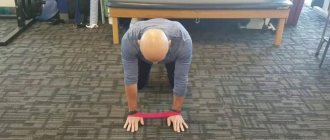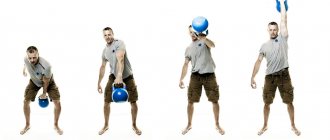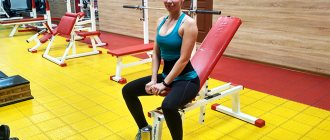Very few articles are devoted to the pace of exercises in bodybuilding. Even in ordinary articles on training methods, you will very rarely find a mention of exactly how fast you should perform the approach. So it turns out that a novice athlete does not think about this most important component of training at all. As training progresses, almost everyone develops the habit of following a certain average pace of performing the exercise: quickly lifting the weight, slowly lowering it. But why is this necessary and what does varying the tempo provide? Almost no one thinks about this.
Time under load
American strength training specialist Ian King was very closely involved in the study of the influence of the pace of exercise on changes in physical indicators (strength, explosive power, muscle volume, endurance). He outlined his conclusions in the book “Get Buffed,” which was published in 1999. Here are some of them:
- CONCLUSION #1: You need to use a different pace of exercise.
- CONCLUSION No. 2: it is not just the pace of exercise that is important, but the time that the muscle group is under load (TUT - time under tension or VPN - time under load).
As for this indicator, with VPN:
- 1-20 seconds – maximum strength and explosiveness develops
- 21-40 seconds – maximum strength and muscle hypertrophy develops
- 41-70 seconds – endurance and muscle hypertrophy develops
- CONCLUSION #3: Set durations exceeding 70 seconds are excessive; Sets of such duration can be resorted to only in extremely rare cases.
Here it is necessary to clarify that, for example, a set of squats in the “8 Weeks of Hell” program, lasting 120 seconds or more, is actually a set of sets, because during its execution you can stop more than once to rest; VPN is calculated based on the assumption that you do not pause at either the upper or lower points of the amplitude of movement.
Myth #1: All exercises should be done 8-12 reps per set.
This amount is ideal from a muscle building point of view.
Origin of the myth: In 1954, one of the works of Ian McQueen (a famous MD and bodybuilder) recommended performing 8-12 repetitions per set to effectively build muscle mass.
Refutation: this number of repetitions keeps the muscles at medium tension, which does not allow them to develop as much as possible.
Scientific point of view: the highest tension occurs when exercising with heavy weights, which stimulate muscle growth. On the other hand, the total amount of time the muscles are tensed (high repetitions) stimulates the structures around the muscle fibers, which increases their endurance. Option with reps ranging from 8 to 12, somewhere between tension and weight. But if you constantly work at that many reps, you won't give your muscles the high level of tension that you'll only get if you lift heavier weights.
Bottom line: Vary the number of reps with different weights.
Actually about the tempo
Let us recall that the movement consists of a positive (concentric) phase, during which the weight is lifted, and a negative (eccentric), during which the weight is lowered (returned to its original position).
The end of the concentric phase is considered the top point of the amplitude of movement, the eccentric phase is considered the bottom (it’s a little strange to consider the bottom point in lat pull-downs to be the top point, but everything falls into place if you remember that lat pull-downs are “inverted” pull-ups).
Accordingly, when you come across numbers indicating the recommended pace of movement, the first of them will mean the duration of the negative phase, the second - the delay at the lower point of the amplitude of movement, the third - the duration of the positive phase, the last - the delay at the upper point of the amplitude.
Delay at the bottom point of the amplitude is typical for pressing movements, at the top - for traction, down presses or calf raises.
So, “4020” means that the weight is lowered in 4 counts, there is no delay at the bottom point, 2 counts are allocated for lifting, and there is no delay at the top point either. (! Please note: it is not seconds that are indicated here, but precisely the count. That is, pronounced measuredly “one, two” is a rise, “one, two, three, four” is a descent. Four counts are approximately 2.5 seconds. )
4020/4021 and 3020/3021 are precisely the main tempo for performing exercises in bodybuilding; most professional athletes adhere to it.
This is exactly the pace at which sets of 8-12 repetitions will last 30-40 seconds, that is, the work will be aimed at increasing strength and muscle hypertrophy.
If any phase of the movement TAKES 5 SECONDS (note - now seconds) or more, then such a repetition should be considered slow or super-slow. Slow repetitions are performed with strict technique. (What can often be observed in the gym, when the weight is lifted only with teeth, the body wriggles in wild convulsions, and the barbell (dumbbells) “walks” here and there, is not slow repetitions).
We’ll talk about slow and “explosive” repetitions a little lower, but for now everyone, especially beginners in training, should remember:
IF YOU CANNOT LIFT THE WEIGHT “ONE, TWO”, IT MEANS IT IS TOO BIGGER FOR YOU AND IT NEEDS TO BE LOWERED. OPTION: YOU SHOULD STOP THE APPROACH BECAUSE YOU ARE ALREADY TOO TIRED
At the same time, “pros” often use the 2010 pace. Almost always, for example, four-time “Mr. Olympia” Jay Cutler works at this pace. Why?
- Firstly, this pace makes it possible to take slightly more weight,
- secondly, at this pace it is often possible to perform more repetitions.
Very often this technique involves light cheating. As for the time under load, it is not much different from what you can achieve at 4020/4021 pace.
Physiology and benefits of reduced amplitude
Let's compare what happens when an athlete performs an exercise in full and short amplitude.
Blood supply to muscles
At full range of motion, blood circulates more easily to and from muscle tissue. Partial amplitude seriously complicates blood flow due to pinched vessels and capillaries, since the muscle does not relax. The outflow of blood from working muscle tissue is difficult when the amplitude is partial. During this approach, more flows into the muscle than flows out, which creates “clogging.” This is actually why all the most effective pumping methods contain a partial amplitude.
It has long been believed that the heart is the only pump in the human body that drives blood through the systemic circulation. Nowadays, data on the topic that muscles are special peripheral “hearts” that locally “push” blood through the vessels is a proven fact. All the power of the heart is 99% lost in the capillary network and it is not enough to “close the circle” of blood circulation. Assistants needed. Muscles are the main assistants of the heart in this regard.
This hydraulic pumping task occurs when muscle contractions alternate with muscle relaxations. Scientifically, this is called a venous pump. It is this method that actively functions with full repetitions at full amplitude (contractions alternate with relaxations).
With partial repetitions, the venous pump mechanism is hindered, which leads to two important things:
- intense pumping - pumping the working muscle with blood;
- the load on the heart increases . With partial amplitude, the vessels are compressed, the heart needs to create more pressure to push blood through the tight gaps.
We recommend Underground 48. 100,000 witnesses of Borisov
Moreover, there is evidence that when stretching muscle tissue in the lower part at full amplitude, metabolic processes in the muscles increase. Sensitivity to hormones may increase, and the activity of local growth factors may increase. Therefore, after the approach (especially in partial form), it is definitely worth stretching the worked muscle.
ligaments and joints
With partial amplitude, the load on the ligaments and joints is reduced. The load during the exercise is not uniform throughout the entire length of the amplitude of movement. At the beginning it is always much larger than in the middle.
The muscle is attached through a ligament to the bone at too great an angle (usually about 180 degrees). As you contract, the angle becomes smaller (closer to 90 degrees), which means it becomes easier to lift the weight. You've probably noticed that the most difficult thing to do is start the movement (go through the first quarter of the amplitude). If the angle is too large, the muscles cannot develop their maximum strength on one side and therefore the ligaments and joints on the other side are forced to take on this load.
Both of these conclusions are actively used in sports. It is the short amplitude that is used to break through the ceiling of strength achievements in powerlifting. Let’s say an athlete bench presses 180 kg a couple of times at full amplitude. The power rack and partial amplitude will allow him to lift a weight of 200 kg, since the muscles in the short amplitude are stronger. There are two significant advantages:
- Muscles receive more stress because... work with heavy weights
- Golgi tendon organ deception
Golgi organs inhibit muscle contraction. This is the body’s original “insurance” for an emergency, during which the body’s internal strength reserves are released. The Golgi organs send a blocking signal to muscle contraction, and the heavier the weight on the bar, the more the Golgi organs are activated. When using large weights, adaptation to the heavy load occurs and blocking impulses of lower intensity are sent. This is why when you return to lighter weights (at full range), they seem lighter.
Another thesis - the smaller the amplitude, the less the ligaments are loaded, is also actively used in sports. When working with large weights, the initial part of the amplitude and the final part are removed to make the movement safer for ligaments and joints. For example, when curling your arms with a barbell, start not with your arms fully straightened at the elbows, but with a slight bend. It is safer to do bends in this position.
Thus, partial repetitions are not a constant basis of your training, but a part of it. Only a balanced and reasonable approach. Like the Mentzer system, the Joe Weider system, partial reps will work, BUT not always and not for everyone.
If so, then we need to determine the optimal time to use partial repetitions. In other words, when can they be used for maximum benefit.
Explosive Replays
An “explosive” repetition refers to attempting to lift the weight as quickly as possible. Although the lowering is controlled (the weight is not just thrown down, but rather lowered), it also occurs at a fairly fast pace. To perform an exercise in an explosive style, the weight of the weight must be significantly reduced.
According to Ian King, explosive reps will only build maximal and explosive strength. Practice, however, shows that their implementation can be very useful for muscle hypertrophy.
By performing explosive reps, you will specifically target type IIb fibers that would otherwise be left largely unused. In addition, this style of performing repetitions involves the inclusion of more muscles in the work.
There is also a third reason, but it does not concern muscle hypertrophy: explosive training increases the body’s energy consumption, which means it is suitable for getting rid of excess subcutaneous fat.
We emphasize once again: THE WEIGHT OF THE WEIGHT SHOULD BE SIGNIFICANTLY REDUCED, USUALLY IT IS NO MORE THAN 50% OF YOUR ONE-TIME MAXIMUM. THE APPROACH SHOULD BE STOPED AS SOON AS THE SPEED OF REPETITIONS DECREASES AT LEAST A Slightly (USUALLY YOU CAN PERFORM 5-8 REPS IN AN “EXPLOSIVE” STYLE IN AN APPROACH)
Slow negatives
Slow “negatives” are useful when working towards muscle hypertrophy. As for strength indicators, slow “negatives” turn out to be effective for short-term increases and are virtually useless over a long period of time. That is, you should use slow negatives only in the immediate vicinity of the start, if we are talking about competitions in which the most important indicator is maximum strength.
An interesting point made by Ian King regarding the "negatives" is that he insists that the MAIN WORK DURING THE NEGATIVE PHASE OF THE MOVEMENT IS DONE IN THE LOWER THIRD OF THE AMPLITUDE. THAT IS, THERE IS NO SENSE IN STARTING THE MOVEMENT SLOWLY SO THAT AT SOME MOMENT JUST DROP THE WEIGHT. It’s better to quickly go through the upper half of the amplitude so that the main forces are spent on slow movement in the lower one.











